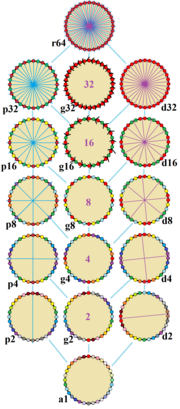Triacontadigon
| Regular triacontadigon | |
|---|---|
 A regular triacontadigon | |
| Type | Regular polygon |
| Edges and vertices | 32 |
| Schläfli symbol | {32}, t{16}, tt{8}, ttt{4} |
| Coxeter diagram | |
| Symmetry group | Dihedral (D32), order 2×32 |
| Internal angle (degrees) | 168.75° |
| Dual polygon | Self |
| Properties | Convex, cyclic, equilateral, isogonal, isotoxal |
In geometry, a triacontadigon (or triacontakaidigon) or 32-gon is a thirty-two-sided polygon. In Greek, the prefix triaconta- means 30 and di- means 2. The sum of any triacontadigon's interior angles is 5400 degrees.
An older name is tricontadoagon.[1] Another name is icosidodecagon, suggesting a (20 and 12)-gon, in parallel to the 32-faced icosidodecahedron, which has 20 triangles and 12 pentagons.[2]
Regular triacontadigon[edit]
The regular triacontadigon can be constructed as a truncated hexadecagon, t{16}, a twice-truncated octagon, tt{8}, and a thrice-truncated square. A truncated triacontadigon, t{32}, is a hexacontatetragon, {64}.
One interior angle in a regular triacontadigon is 1683⁄4°, meaning that one exterior angle would be 111⁄4°.
The area of a regular triacontadigon is (with t = edge length)
and its inradius is
The circumradius of a regular triacontadigon is
Construction[edit]
As 32 = 25 (a power of two), the regular triacontadigon is a constructible polygon. It can be constructed by an edge-bisection of a regular hexadecagon.[3]
Symmetry[edit]
The regular triacontadigon has Dih32 dihedral symmetry, order 64, represented by 32 lines of reflection. Dih32 has 5 dihedral subgroups: Dih16, Dih8, Dih4, Dih2 and Dih1 and 6 more cyclic symmetries: Z32, Z16, Z8, Z4, Z2, and Z1, with Zn representing π/n radian rotational symmetry.
On the regular triacontadigon, there are 17 distinct symmetries. John Conway labels these lower symmetries with a letter and order of the symmetry follows the letter.[4] He gives r64 for the full reflective symmetry, Dih16, and a1 for no symmetry. He gives d (diagonal) with mirror lines through vertices, p with mirror lines through edges (perpendicular), i with mirror lines through both vertices and edges, and g for rotational symmetry. a1 labels no symmetry.
These lower symmetries allows degrees of freedoms in defining irregular triacontadigons. Only the g32 subgroup has no degrees of freedom but can seen as directed edges.
Dissection[edit]
 regular |
 Isotoxal |
Coxeter states that every zonogon (a 2m-gon whose opposite sides are parallel and of equal length) can be dissected into m(m-1)/2 parallelograms.[5] In particular this is true for regular polygons with evenly many sides, in which case the parallelograms are all rhombi. For the regular triacontadigon, m=16, and it can be divided into 120: 8 squares and 7 sets of 16 rhombs. This decomposition is based on a Petrie polygon projection of a 16-cube.

|
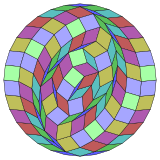
|

|
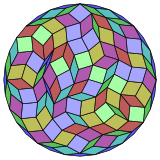
|
Triacontadigram[edit]
A triacontadigram is a 32-sided star polygon. There are seven regular forms given by Schläfli symbols {32/3}, {32/5}, {32/7}, {32/9}, {32/11}, {32/13}, and {32/15}, and eight compound star figures with the same vertex configuration.
| Regular star polygons {32/k} | |||||||
|---|---|---|---|---|---|---|---|
| Picture | 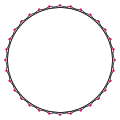 {32/3} |
 {32/5} |
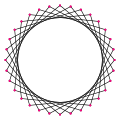 {32/7} |
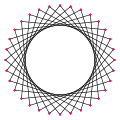 {32/9} |
 {32/11} |
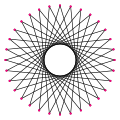 {32/13} |
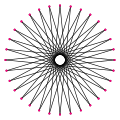 {32/15} |
| Interior angle | 146.25° | 123.75° | 101.25° | 78.75° | 56.25° | 33.75° | 11.25° |
Many isogonal triacontadigrams can also be constructed as deeper truncations of the regular hexadecagon {16} and hexadecagrams {16/3}, {16/5}, and {16/7}. These also create four quasitruncations: t{16/9} = {32/9}, t{16/11} = {32/11}, t{16/13} = {32/13}, and t{16/15} = {32/15}. Some of the isogonal triacontadigrams are depicted below as part of the aforementioned truncation sequences.[6]
| isogonal triacontadigrams | ||||||||
|---|---|---|---|---|---|---|---|---|
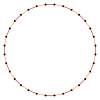 t{16} = {32} |

|

|
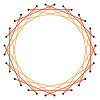
|

|

|

|

|
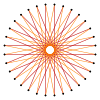 t{16/15}={32/15} |
 t{16/3} = {32/3} |

|
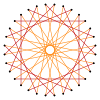
|

|

|
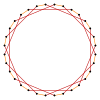
|

|

|
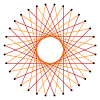 t{16/13}={32/13} |
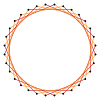 t{16/5} = {32/5} |
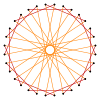
|
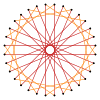
|

|

|

|

|

|
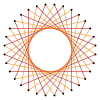 t{16/11}={32/11} |
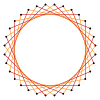 t{16/7} = {32/7} |

|

|

|
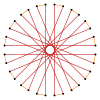
|

|
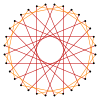
|

|
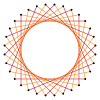 t{16/9}={32/9} |
References[edit]
- ↑ A Mathematical Solution Book Containing Systematic Solutions to Many of the Most Difficult Problems by Benjamin Franklin Finkel
- ↑ Weisstein, Eric W. "Icosidodecagon". MathWorld.
- ↑ Constructible Polygon
- ↑ John H. Conway, Heidi Burgiel, Chaim Goodman-Strauss, (2008) The Symmetries of Things, ISBN 978-1-56881-220-5 Search this book on
 . (Chapter 20, Generalized Schaefli symbols, Types of symmetry of a polygon pp. 275-278)
. (Chapter 20, Generalized Schaefli symbols, Types of symmetry of a polygon pp. 275-278)
- ↑ Coxeter, Mathematical recreations and Essays, Thirteenth edition, p.141
- ↑ The Lighter Side of Mathematics: Proceedings of the Eugène Strens Memorial Conference on Recreational Mathematics and its History, (1994), Metamorphoses of polygons, Branko Grünbaum
- Naming Polygons and Polyhedra
- CRC Concise Encyclopedia of Mathematics, Second Edition, Eric W. Weisstein icosidodecagon
This article "Triacontadigon" is from Wikipedia. The list of its authors can be seen in its historical and/or the page Edithistory:Triacontadigon. Articles copied from Draft Namespace on Wikipedia could be seen on the Draft Namespace of Wikipedia and not main one.




